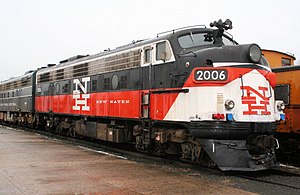EMD FL9

FL9 in New Haven livery
|
|||||||||||||||||||||||||||||||||||||||
|
|||||||||||||||||||||||||||||||||||||||
|
|||||||||||||||||||||||||||||||||||||||
|
|||||||||||||||||||||||||||||||||||||||
|
|||||||||||||||||||||||||||||||||||||||
| Type and origin | |
|---|---|
| Power type | Electro-diesel (diesel-electric/straight electric) |
| Builder | General Motors Electro-Motive Division (EMD) |
| Model | FL9 |
| Build date | October 1956 – November 1960 |
| Total produced | 60 |
| Specifications | |
|---|---|
| Configuration: |
|
| • AAR | B-A1A |
| Gauge | 4 ft 8 1⁄2 in (1,435 mm) |
| Length | 59 ft 0 in (17.98 m) |
| Loco weight | 287,000 lb (130,000 kg) |
| Electric system(s) | 660 V DC Third rail |
| Current source | Contact shoe |
| Prime mover |
EMD 567C (2000–2029), EMD 567D1 (2030–2059) |
| Engine type | V16 Two-stroke diesel |
| Aspiration | Roots blower |
| Displacement | 9,072 cu in (148.663 L) |
| Generator | DC generator |
| Traction motors | DC traction motors |
| Cylinders | 16 |
| Cylinder size | 8.5 in × 10 in (216 mm × 254 mm) |
| Transmission | Electric |
| Loco brake | Straight air, original 24RL later 26C |
| Train brakes | Air |
| Performance figures | |
|---|---|
| Maximum speed | 89 mph (143 km/h) |
| Power output |
567C: 1,750 hp (1,300 kW), 567D1: 1,800 hp (1,300 kW) |
| Tractive effort | 53,200 lbf (236.6 kN) (Starting) 29,500 lbf (131.2 kN) (Continuous) @ 9.3 mph |
| Career | |
|---|---|
| Operators | New Haven, Penn Central, Amtrak, ConnDOT, Metro-North |
| Class | EDER-5 (2000-2029), EDER-5a (2030-2059) |
| Locale | North America |
| Disposition | a few still in occasional service, some others preserved in museum collections, Metro North's and ConnDot's retired |
The EMD FL9 (New Haven Class EDER-5) is a dual-power electro-diesel locomotive, capable of diesel-electric operation and as an electric locomotive powered from a third rail. Sixty units were built between October 1956 and November 1960 by General Motors Electro-Motive Division for the New York, New Haven and Hartford Railroad (the "New Haven"); The FL9 model was in direct competition with the less popular Fairbanks-Morse dual-power P-12-42 model.
The locomotive was based on the EMD FP9, lengthened to accommodate additional equipment, including a larger train heating steam boiler. Due to the additional weight of the added equipment and the weight restriction on the Park Avenue 97th Street Portal Viaduct, the locomotive was equipped with a three-axle rear truck, giving it an uncommon B-A1A wheel arrangement. The middle axle of the rear truck was not powered. The Flexicoil type of truck was used at both front and rear, due to this type of truck having more room for fitting the third rail shoes and associated equipment.
The locomotive was capable of using either an over-running or under-running third rail by means of retractable shoes operated by pneumatic cylinders. The shoes were retracted to the vertical position outside of third rail territory: if extended, electrically live shoes would have projected towards the low-level station platforms that were the norm until the 1970s. A few early examples were fitted with a small DC pantograph for use within New York City's Grand Central Terminal, where long gaps exist in the third rail because of the complex trackage that includes numerous single and double slip switches and double track ladders. These pantographs were soon removed. The complex trackage remains, but the overhead power rails are long gone.
The third rail could be contacted by dropping the third rail shoe and the power source switched at speed, as could be the reverse transition. Unlike some other dual-power locomotives, such as British Rail's Class 73, the diesel engine is the primary source of power. Third rail capability was required only because of the Park Avenue Tunnel and underground Grand Central Terminal, which lack sufficient ventilation for diesel exhaust. The third rail extended from Grand Central Terminal to Woodlawn Junction at the New York City border, where the New Haven diverged from the New York Central Harlem Division. However, the dual-power locomotives switched to diesel as soon as possible, immediately after leaving the tunnel, due to diesel fuel being cheaper than electricity for Metro North. The New Haven operated the FL9s from third rail power between Grand Central Terminal and 125th Street Station in upper Manhattan.
...
Wikipedia
